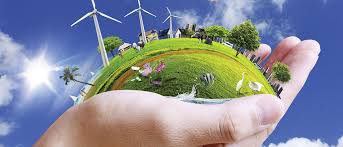SUSTAINABLE ENERGY
SUSTAINABLE ENERGY
 This
sets sustainable energy apart
from other renewable energy terminology such as alternative energy by focusing on
the ability of an energy source to continue providing energy. Sustainable
energy can produce some pollution of the environment, as long as it is not
sufficient to prohibit heavy use of the source for an indefinite amount of
time. Sustainable energy is also distinct from low-carbon energy, which is sustainable only in
the sense that it does not add to the CO2 in the atmosphere.Green
Energy is energy that can be extracted, generated, and/or consumed without any
significant negative impact to the environment. The planet has a natural
capability to recover which means pollution that does not go beyond that
capability can still be termed green.Green power is a subset of renewable
energy and represents those renewable energy resources and technologies that
provide the highest environmental benefit. The U.S. Environmental Protection Agency defines
green power as electricity produced from solar, wind, geothermal, biogas, biomass and
low-impact small hydroelectric sources. Customers often buy
green power for avoided environmental impacts and its greenhouse
gas reduction benefits.
This
sets sustainable energy apart
from other renewable energy terminology such as alternative energy by focusing on
the ability of an energy source to continue providing energy. Sustainable
energy can produce some pollution of the environment, as long as it is not
sufficient to prohibit heavy use of the source for an indefinite amount of
time. Sustainable energy is also distinct from low-carbon energy, which is sustainable only in
the sense that it does not add to the CO2 in the atmosphere.Green
Energy is energy that can be extracted, generated, and/or consumed without any
significant negative impact to the environment. The planet has a natural
capability to recover which means pollution that does not go beyond that
capability can still be termed green.Green power is a subset of renewable
energy and represents those renewable energy resources and technologies that
provide the highest environmental benefit. The U.S. Environmental Protection Agency defines
green power as electricity produced from solar, wind, geothermal, biogas, biomass and
low-impact small hydroelectric sources. Customers often buy
green power for avoided environmental impacts and its greenhouse
gas reduction benefits.
Sustainable
energy is energy
that is consumed at insignificant rates compared to its supply and with
manageable collateral effects, especially environmental effects. Another common
definition of sustainable energy is an energy system that serves the needs of
the present without compromising the ability of future generations to meet
their needs. The organizing principle for
sustainability is sustainable development, which includes
the four interconnected domains: ecology, economics, politics and culture. Sustainability science is the study
of sustainable development and environmental science.
Technologies promote sustainable energy
including renewable energy sources, such as hydroelectricity, solar energy, wind energy, wave power,
geothermal energy, bioenergy, tidal power and
also technologies designed to improve energy efficiency. Costs have decreased
immensely through out the years, and continue to fall. Increasingly, effective
government policies support investor confidence and these markets are expanding.
Considerable progress is being made in the energy
transition from fossil fuels to ecologically sustainable
systems, to the point where many studies support 100% renewable energy.
Among sources of renewable energy,
hydroelectric plants have the advantages of being long-lived many existing
plants have operated for more than 100 years. Also, hydroelectric plants are
clean and have few emissions. Criticisms directed at large-scale hydroelectric
plants include: dislocation of people living where the reservoirs are planned,
and release of significant amounts
of carbon dioxide during construction and flooding of the reservoir.
However,
it has been found that high emissions are associated only with shallow
reservoirs in warm (tropical) locales, and recent innovations in hydropower
turbine technology are enabling efficient development of low-impact run-of-the-river hydroelectricity projects. Generally
speaking, hydroelectric plants produce much lower life-cycle emissions than
other types of generation. Hydroelectric power, which underwent extensive
development during growth of electrification in the 19th and 20th centuries, is
experiencing resurgence of development in the 21st century. The areas of
greatest hydroelectric growth are the booming economies of Asia. China is the
development leader; however, other Asian nations are installing hydropower at a
rapid pace. This growth is driven by much increased energy costs especially for
imported energy and widespread desires for more domestically produced, clean,
renewable, and economical generation.
Comments
Post a Comment